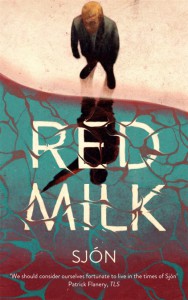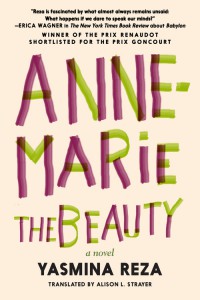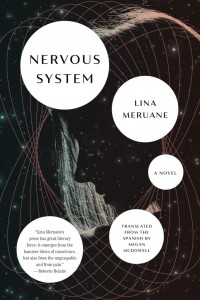We take our jobs of bringing you the best new releases from the realm of world literature very seriously, and this week, we have four astounding texts from authors notorious for their intelligence, their variousness, and their ability to captivate. From Iceland, Sjón explores the banality of evil in a charged, probing character study. In Argentina, the legendary Norah Lange comes to new light as she evolves beyond her reputation as a literary muse, and tells her story in her own, singular language. The latest from French writer and playwright Yasmina Reza is a poignant meditation, guided by oratory, on selfhood, aging, and human frailties. And lastly, Chile’s award-winning Lina Meruane comes out with an exploration of illness and intergenerational trauma that is at once dreamy and deeply grounded in physicality. Read on to find out more!

Red Milk by Sjón, translated from the Icelandic by Victoria Cribb, Sceptre, 2021
Review by Lindsay Semel, Assistant Managing Editor
Sjón, one of Iceland’s most internationally recognizable literary figures, is a lifelong cultural miscegenationist. Since his earliest days as a neo-surrealist poet and musician, he has drawn proudly and liberally from global artistic lineages. In Red Milk, his latest collaboration with long-time translator Victoria Cribb, he employs an intentional, methodical restraint to examine the survival of Nazism post-World War II through the life and early death of Gunnar Kampen, a fictionalized version of a real, small-time Icelandic neo-Nazi. Sjón’s policy of omission—of drama, psychology, violence, grandeur of any kind—results in a delicious tension. He tempts us to expect so much of the novel, and though he never provides the relief of clean culminations, he manages to keep the reader wanting.
More than anything, we want Gunnar to either damn or to redeem himself, but he refuses to be anything more than a tempest in a teacup—a chess piece carved in ivory rather than ebony. He passes his brief life engaged in the mundane building of a movement that never comes to fruition. He stumbles into nationalist socialism the same way any young person stumbles into their solidified adult identity. This is not a psychoanalytic assessment of what draws him to Nazism so as much as a collection of images, inputs, choices, and feedback that nudge him there. One such curious image comes from a party he attended with his parents as a child. Bored with the adults, he wanders through the house until he encounters “a human figure, sitting in the shadow thrown by the curved back of the armchair,” in the library. He marvels at her brown skin and colorful clothing.
Without releasing her grip on his left hand, she raises his right hand and pulls it under the lampshade, holding it up to the strong bulb until the light shines red through the child’s flesh, revealing the silhouettes of the bones inside.
‘Only possible with such a hand.’
The woman nods at him. The filigree brooch on her shoulder gleams, exposing the pattern from which it is made: a myriad tiny swastikas that differ from the hated one only in that they stand upright rather than tilted on their side.
‘Only white people let the light into themselves.’
The imagery is not attributed any meaning besides its own aesthetic potency. The woman’s exoticism is a neutral source of intrigue for Gunnar, unrelated to his blossoming racial beliefs. The woman—as an ideologically educated Gunnar discovers later—might well have been Savitri Devi, the all too real mother figure of contemporary neo-Nazism, but Gunnar’s brush with history is told with the same tone as if she had simply been Reykjavik’s witchy spinster.
The early pages of the book are loud with similarly raw impressions of early childhood. In Gunnar’s first memory of consciousness, he watches his house “becoming so small that he would never fit back inside” from the back window of his car. In Sjón’s typically distilled style, this brief phrase frames Gunnar’s entire character with a misunderstanding of perspective and an inherent disassociation from his family’s interior life. Cribb’s translation gorgeously maintains the economy of Sjón’s writing; by resisting the urge to elaborate, by committing to word choice with a poetic conscious, it protects in English the potential for diverse interpretations.
In describing Gunnar’s family, Sjón employs a selective intimacy and a simmering brutality, in which a portrait-esque description subtly hints at underlying emotion. We have to choose to make meaning from details. When Gunnar is an adult, for example, his older sisters come to visit him in his hospital bed. He watches their conversation without participating. The narrator observes, as if through Gunnar’s eyes, “Whenever one is speaking, the other swivels her hand in sympathy— but never in time—as if recalling a dance they mistakenly believe they once danced together.” We are left to imagine which dance it may have been, as well as the haunting pain of failed connection.
When Gunnar passes from the memory pearls of his childhood to his fanatical youth, we learn about him through his correspondences and publications. His sense of perspective remains distorted; he continues to perceive himself as bigger than his environment. Much like Sjón himself, Gunnar was an avid reader from an early age and never questions the idea that his destiny is to participate in, rather than solely consume, the ideological conversations of his milieu. Full of youthful zeal, he writes an almost charming letter to the editors of his favorite right-wing magazine, The Dawn, to inquire if they “might consider publishing letters from [their] subscribers in which we would have a chance to air our views on the issues in question.” Utterly devoid of self-doubt, the letter foreshadows the correspondence that Gunnar will later initiate with the movement’s international cadre of leaders. It is exactly this dissonance between ambition and invisibility, between an inflated sense of self and a negligible social impact, that drew Sjón to Gunnar’s historical antecedent in the first place. “P.S.,” the young Gunnar closes his letter, “It occurs to me that a column of readers’ letters could be called ‘From the Shore’. For what fairer place exists from which to watch the dawn?”
Nazism, along with its contemporary iterations, is one of the most immeasurably destructive forces of our era. But Gunnar Kampen isn’t. In the theater of World War II, in Gunnar, and in the form of countless other Nazi protagonists who died without realizing their vision in its fullness, the ideology’s many heads have been chopped off one by one. But the lurking question remains of how to defeat the beast itself. Gunnar associates himself with this giant monster, and yet he himself is so small. In this way, the novel offers not so much a comment on the dangers or the spread of fascism as on the very littleness, the randomness, of being human. The novel turns a monster into a shadow. But it is a trick. The monster is real.

Notes from Childhood by Norah Lange, translated from the Spanish by Charlotte Whittle, And Other Stories, 2021
Review by Jacqueline Leung, Editor-at-Large for Hong Kong
From publishing discourse, it would seem that Norah Lange is known first and foremost as a muse for literary men. Born in 1905 to Norwegian parents in Buenos Aires, Lange is often mentioned alongside Jorge Luis Borges—her distant cousin and supposed admirer—and writers of the literary magazine Martín Fierro, who would have attended some of the bohemian tertulias she hosted at her family home on Calle Tronador. A striking redhead known for making flamboyant speeches, Lange was a captivating personality in Argentine literary circles, and her reputation overshadowed her identity as a writer and poet for the greater half of the twentieth century. In fact, most of Lange’s eleven works had been out of print, and it was not until the 2018 release of her novel People in the Room—also translated by Charlotte Whittle (who was introduced to Lange coincidentally, by a friend with the near-identical name of Nora Lange)—that readers in English started having conversations about the author’s neglected legacy.
Notes from Childhood, published in 1937 as Cuadernos de Infancia, was written early in Lange’s career when she was experimenting with influences and beginning to source inspiration from her personal history. Any sort of life-writing is in part a conscious act to reclaim one’s narrative, and through some eighty vignettes of her childhood between rural Mendoza and suburban Buenos Aires, Lange recalls poignant episodes from her childhood—times spent with her mother and siblings in joy and bereavement, and the limitless curiosities of domestic life, so strange and daunting when viewed from the throes of prepubescent obsession. Each entry is no longer than several pages, like fragments fished out of memory. The book departs from the patriarchal tradition of autobiography, focusing on the private, domestic sphere—the uncertainties of growing up and the oscillation between respect and vexation among sisters. It may even be said that Lange came of age in an absence of masculinity: her father passed away early and her only brother, Eduardito, is the second-youngest sibling the sisters fawn over.
Lange’s prose is mesmerizing and poetic, with painterly qualities that give luminosity to detail and cinematic timing for impact. In her translator’s note, Whittle explains her considerations behind translating the book’s first word, “entrecortado,” as “flickering,” a nod to the development of visual technologies in the 1900s and 1910s that seeps into Lange’s prose, like the growing popularity of photographic portraits and the emergence of film. But flickering also conjures the unstable workings of memory, the inexplicability of some things being in sharp focus while others remain obscure. In Lange’s composition of Notes from Childhood, it is clear that her gaze is partial, both in terms of telling in retrospect but also the portraying of the world as it was to her, half-formed and half-understood in a child’s mind. An early vignette portrays Lange’s mother on horseback and in chiaroscuro, like artwork, suggesting both reverence and distance: “On one side of the horse, we saw the whole length of her, the black brim of her hat concealing her face. We saw only a single gloved hand on the other, yet her profile was as sharp as if she had suddenly drawn alongside a lamp.”
Other times, the reader catches Lange peeking through tree branches, windows, and from behind doors. She is equally conscious of how she is seen by others, as one feels in the process of identity formation. On one occasion, when Lange was four, her mother and sisters dressed her in a suit with fasteners and a jacket, inadvertently acting upon people’s comments of Lange’s appearance, which had confused people about her gender. As soon as Lange grew aware, she felt ridiculed and cried: “I don’t want to be a boy! I don’t want to be a boy!” Ten years later, Lange is considerably more performative, calling attention to herself by hollering at the rooftops dressed in a poncho and a man’s felt hat, her need to express herself overriding her fear of being misidentified (in the unlikely case that her neighbors were still unaware of the raucous Lange children). As Lange grows with the narrative, readers see her transformation from an awkward, perceptive child to an eccentric young lady who, despite her insecurities, was not entirely afraid to name her fears.
Sorrow has a special place in Notes from Childhood. Death as an unknown concept that grows steadily nearer for the young Lange—through the passing away of animals, the first glimpse of a corpse, and finally the tangible deaths of her father and her little sister, Esthercita. In both family tragedies, Lange’s narrative shows mourning to be a deeply personal and alienating experience. Tears do not form as they should, and solace is found in most unusual practices. In Calle Tronador, Lange associates the death of Esthercita with three red tiles in the old courtyard, which Lange felt compelled to cross with a short step and a long leap up until adulthood. The gesture acts like a promise to her sister and also represents a kind of reassurance one finds at unassuming times and locations. Preserving these moments, Lange gives voice to the rich, generous childhood that has shaped her, as well as all that she lost in the journey to her present. Notes from Childhood takes place in turbulent times, but it makes resounding echoes with the depths of human relationships and a girl’s place in the world—how life seems to come in arcs but is only looked back on in pieces, scattered and together all at once.

Anne Marie the Beauty by Yasmina Reza, translated from the French by Alison L. Strayer, Seven Stories, 2021
Review by Sarah Moore, Blog Editor
Anne-Marie the Beauty is the latest dramatic work from French writer and playwright Yasmina Reza—best known for her 1994 play Art (published in English translation by Christopher Hampton in 1996). This new play takes the form of a monologue by a retired actress; looking back over her career, she reflects upon ambition, success, love, friendship, and aging. I had the pleasure of attending the premier performance of this work in person at the La Colline theatre in Paris during the brief hiatus in lockdown restrictions during the summer of 2020, with the titular role played by André Marcon. Especially in the aftermath of the lockdown, the performance astounded me with its intimacy, warmth, and nostalgia for life’s details; I was intrigued to see how that would be managed in the English text, as the candour and humour of Anne-Marie’s inimitable voice is the main impetus between the play’s success. Without it, the structure would collapse. However, Alison L. Strayer’s deft translation captures Anne-Marie’s tone, which is no mean feat in a text so abundant with idioms, idiosyncrasies, and poignant comedy.
Anne-Marie the Beauty is a hymn to the unknowns: to those who have lived, loved, and worked outside of fame and recognition. She recounts the story of her own childhood and career, but the heart of the text is also about the people she knew—their adventures and relationships. Of course, the irony is that this all happens in the world of theatre, where every actor hopes for their own name to dominate the playbill and their moment to come, before “[the] wheel goes round and turns you into a shadow.” The tension between success and failure, between glory and wretchedness, runs deep throughout. Anne-Marie dreamed of being a film star, but she didn’t have the figure—as she says herself. Instead, it is at the Théâtre de Clichy where she takes the stage, along with her beloved and headstrong childhood friend, Giselle. Giselle, with her stunning beauty, achieved greater professional success than Anne-Marie, and yet does not escape tragedy. The entire monologue is an answer to a journalist who has recently come to ask Anne-Marie questions following Giselle’s recent death.
You start out as little people, and you’re little people in the end
It’s this cruel phrase uttered by Anne-Marie that sets the tone for her contemplation. She is under no illusion, yet it is her clear-eyed, frank assessment and observations that makes the text such a joy. It’s rare that a work so wonderfully captures tragedy and delight so seamlessly, and although the play is short, it has the effect of a much longer work.
Reza excels in capturing how our lives are so often lived as attempts to become other people: to aspire, to admire, to alter, to better ourselves. Anne-Marie’s mother covers her face with powder and rouge while Anne-Marie cuts out pictures of Brigitte Bardot and poses as Nancy Sinatra. While we hear of the various roles that she played during her career, Anne-Marie the Beauty is herself a role, created out of hope for a life far away from her lonely and impoverished childhood in Saint-Sourd:
In the magazines, I always looked for photos of Brigitte
Bardot. I clipped them out and pasted them in an album
that I showed to invisible visitors
I narrated episodes from my life, turning the pages
with modesty because of course this beauty was me.
Anne-Marie the Beauty
Throughout her narration, Anne-Marie lets all pretence fall, as if the journalist’s interrogation has provoked a commitment to speaking only the truth. And whilst this is a work which grapples with bigger, overarching questions, it is in the small details of truth that the “beauty” of Anne-Marie’s voice shines through:
I had a nice husband. Uncomplicated
His pet activity was repainting the apartment
He always wanted to repaint, repaint, repaint. He was wild about making things fresh again
I was bored with my husband, but you know, boredom is part of love
He talked to me about his expert appraisals in termite control. We played Scrabble
Whilst a monologue, the other characters are vividly present. This is a work that forces you to ask the question of every name you hear: “Who are they? Who are they really?”

Nervous System by Lina Meruane, translated from the Spanish by Megan McDowell, Graywolf Press, 2021
Review by Alyea Canada, Assistant Editor
Lina Meruane’s Nervous System is a curious little book, both deeply intimate and widely relatable. Ella, a young woman, struggles to finish her dissertation in astrophysics and, under the fear of disappointing her father, wishes for an illness to excuse her from her work. When she is then struck by mysterious pain and numbness, the story starts to unspool, drawing in the medical histories of her boyfriend and the rest of her family. Meruane’s writing plays with linguistic failures as Ella attempts to communicate her illness to her family and doctors, and translator Megan McDowell does an excellent job of balancing the sentence-level manipulations of language with the coldness of rendering a woman’s breakdown in slow-motion. Ominously at work is a wider narrative about the ways illness and violence, both personal and national, continue to live in the long-term memory of the body.
The intimacy gap is a term used in some medical communities to describe the specific oddity of the doctor-patient relationship; doctors know so much about the internal functions of a patient’s body, while the patient knows nothing of the doctor. In Nervous System, Meruane recreates this phenomenon writ large. By the end of the book, we have a detailed familiarity with these characters’ medical histories, but haven’t learned much about them personally, not even their names. The main characters are Ella and her boyfriend, El, but could also be She and He. Ella’s family consists of The Father, The Mother (actually a stepmother, as Ella’s mother died in childbirth), The Twins, and the Firstborn. The decision to leave Ella’s and El’s names in Spanish continues to play with the false intimacy of the novel. Ella and El sound to English readers like names, as opposed to labels, and these are the characters whose illnesses are rendered most viscerally, as a result feel the most real. But upon closer inspection, we only know marginally more about them than we do the other characters.
Ella’s initial illness—mysterious pain and numbness on one side of her body—at first seems psychosomatic given the timing and the fact that pain is one of the hardest symptoms to quantify externally. As she continues to seek a diagnosis, the clues that her illness may be related to trauma start to stack up.
Bad memories assail her. The call informing her of the attack at El’s excavation. El’s head, all bandaged full of silence, and hers full of fear. She’s besieged by imaginary radioactive stations—bombs made of the same hydrogen that lights the start—with pigeons shitting oxide all over them.
This is one of the first hints that there is a lot of personal trauma in Ella’s past. Her biological mother died in childbirth, the Mother survived cancer, and the Father’s health is in decline. Still, as each of the familial illnesses haunting her are dismissed, it becomes clear that there are no easy answers to be had.
As the story widens to encompass the other characters, it still remains internally focused. We learn other character’s illnesses but not where or who they are, and we only know them as they relate to Ella. There are oblique references to state violence: El works as a forensic scientist identifying bodies in mass graves, there are constant protests and references to migrants, Ella and the Firstborn had childhoods “under dictatorship,” and even the death of their biological mother is noted as an anomaly, under the context that “[w]omen gave birth in the most adverse circumstances, but they die of other kinds of violence.” El’s job not only emphasizes the disposability of certain bodies—namely migrants and victims of state violence—but also the continuous trauma of a community emerging from dictatorship. There is a simmering violence underlying many of the interactions between El and Ella as they tiptoe around each other and their ailments. In sharp contrast is the relationship between Ella and the Firstborn, who has no issue reminding Ella that she is responsible for their mother’s death. For both men, their hurt is continuous and constant, and takes aim at Ella who dutifully absorbs it. In a different way, the Mother too seeks to reproduce her pain and illness on Ella, proposing causes of Ella’s illness that are mined from her own history.
Perhaps the most distinctive thing about this novel is that it takes place in tenses more so than on a timeline. Much like the universes Ella studies, the narrative is constantly wrapping around itself, expanding and contracting. It is broken into five chapters, each named after a space phenomenon (black holes, stardust, Milky Way) and assigned a time period (the restless present, past imperfect, future time). As a result there is a certain dreamlike timelessness to the story as it unfolds; it is feels like a distant memory. Ella’s voice shifts and multiplies as her thought process encompasses tangents, reveries, and horrors. After more than a year spent in both isolation and a constant state of crisis, there is something deeply familiar to Ella’s out-of-time quality. Moreover, for much of the world, the past year has been marked by the failure of systems, both physiological and governmental. In a strange way, Nervous System functions as both a mirror and a premonition, simultaneously familiar and unrecognizable.
Nervous System is a quiet novel. McDowell does an excellent job of translating the tenses and tensions, characteristic of Meruane’s lyrical style, in a way that captivates the reader, even though there is little active plot. As Ella turns from the larger systems of outer space to the internal systems of her own body, we are reminded of all the networks we participate in, and of all the ways those networks leave scars. With the pervasive slipperiness of reality and time in this novel, the only thing that feels grounded is the body. Meruane reminds us that bodies are concrete memories, but also that memories can never really be trusted.
*****
Read more on the Asymptote blog:

